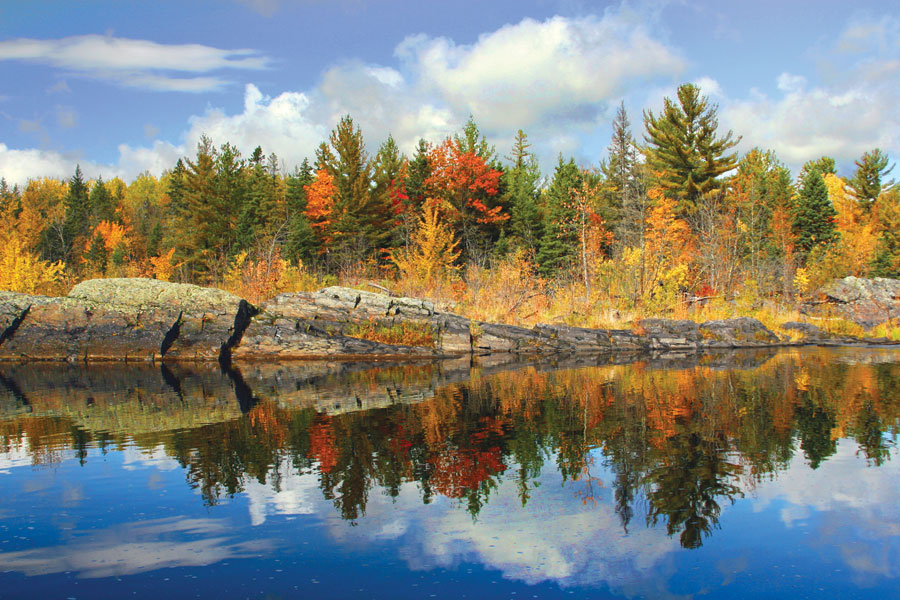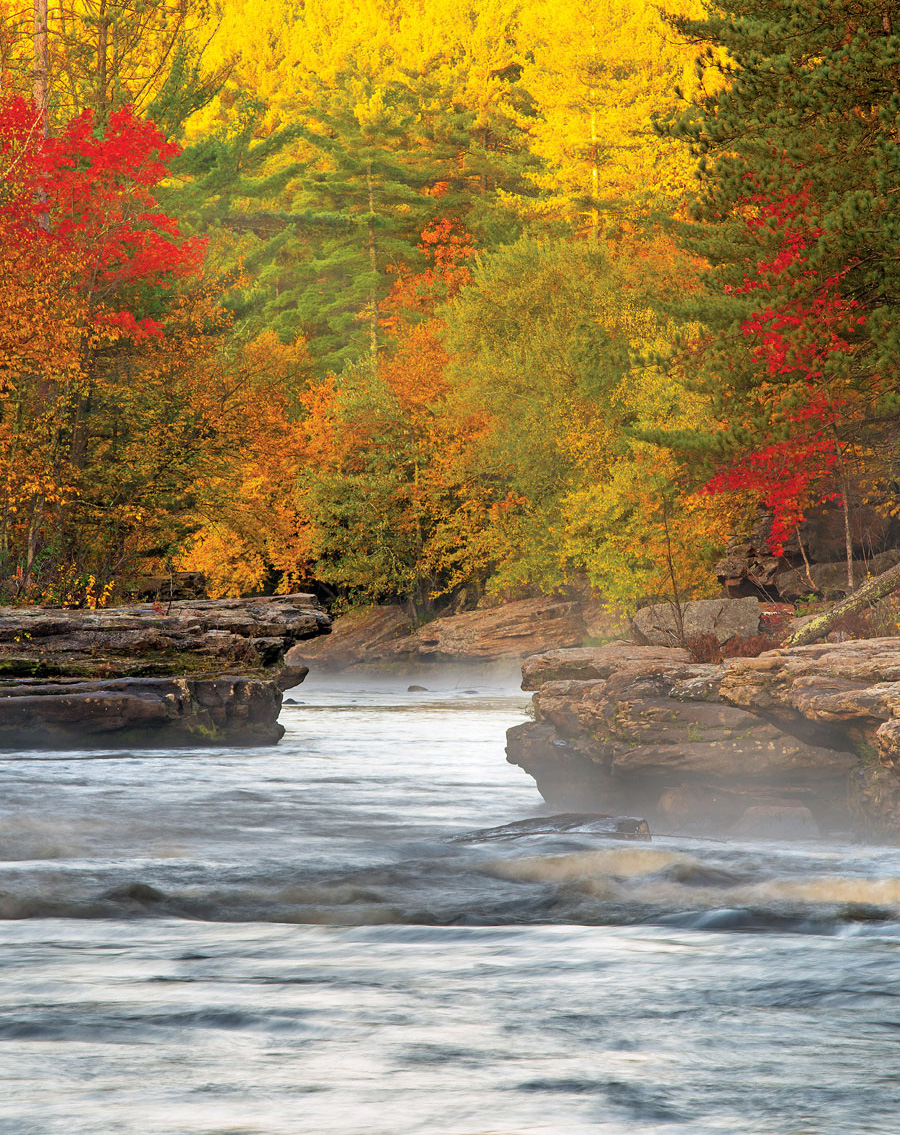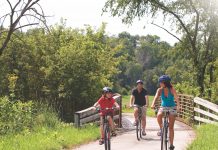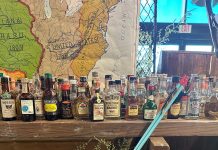
Jay Cooke State Park
Photo by William Wensel
Photographer Doug Ohman and writer Chris Niskanen, the team behind Prairie, Lake, Forest: Minnesota’s State Parks, traveled to all 67 of ’em. We drew on their encyclopedic knowledge to recommend the best parks for various outdoor activities. (And, by the way, if you’re looking for the state’s most mosquito-free park, that would be Whitewater—its limestone terrain drains quickly, keeping stagnant-water breeding grounds at bay.)
Best Flora
Nerstrand Big Woods, an hour south of the Twin Cities, is home to remnants of maple and basswood woods encountered by the state’s first settlers. Each season features a new wave of blooms—more than 50 varieties of wildflowers, rare Minnesota dwarf trout lilies, wild roses, and more are found along Hidden Falls Trail. At Buffalo River east of Moorhead, the state’s largest remaining natural prairies are home to some 250 plant species and offer another glimpse at pre-statehood Minnesota. Additionally, visitors are welcome to pick morels—the only mushroom one can legally gather within state park boundaries.
Best Fauna
In the prairie of Blue Mounds near Luverne, more than 535 acres of land are fenced off for a herd of about a hundred bison, which are rarely fed by park personnel and roam freely in a natural setting. (Local restaurant the Bluestem serves meat from the herd.) The only family of albino white-tailed deer known to roam the state parks may be spotted in Father Hennepin on Mille Lacs Lake.

Blue Mounds State Park
Photo by Paul Stafford, explore minnesota tourism
Best Geologic Wonders
The waterfalls, bluffs, and rock formations that make up our state parks’ breathtaking scenery are mostly due to age-old glacial activity. Near the Iowa border, Forestville/Mystery Cave hosts the longest of the state’s natural caves. See fossils of ancient sea creatures, watch a river disappear into the ground, and admire Turquoise Lake, which gets its unique color from the minerals in the limestone walls that dissolve in the water. Hill Annex Mine near Calumet is a defunct open-pit ore mine comprising Cretaceous beds of fossils—shark teeth, clams, and other ocean animals—that were formed 86 million years ago.
Best Birding
Frontenac is one of the best parks in the country to see colorful birds in flight, especially warblers. Its location along the Mississippi River and Lake Pepin’s bluffs, prairies, and forests attracts a variety of species—some 260 have been spotted. Afton’s location on the St. Croix River attracts hawks, waterfowl, and migratory birds. And at Minneopa near Mankato, bluebirds have made a comeback due to triangular wooden boxes built to attract what is considered Minnesota’s most popular songbird.
Best Hiking
St. Croix has the most miles of hiking trails at 127—double what the next two parks can claim (Jay Cooke has 50 miles and Itasca 49). Hike lake and riverside trails at North Shore destinations including George H. Crosby Manitou and Tettegouche. Both are just north of Silver Bay, tout just under 25 miles of hiking trails apiece, plus backpacking campsites and connections to the Superior Hiking Trail. Bear Head Lake, just south of Ely, is considered a BWCAW alternative, with the comforts of state park amenities. John A. Latsch near Winona is home to the park system’s steepest hike. It’s well worth the 500-step effort for the scenic reward—bluffs overlooking the Mississippi River. (Looking for more hiking trails? Check out our 10 best (most easy) hikes in Minnesota here.)

Banning State Park
Photo by Shawn Thompson
Best Paddling
Find tranquil waters at Lake Louise south of Rochester where the dam at the Upper Iowa and Little Iowa Rivers calms the streams. Zippel Bay, next to Lake of the Woods, also offers easy paddling opportunities as well as miles of white sand beaches. In the spring, daredevils go to the Kettle River at Banning, just north of Hinckley, for famous rapids including Dragon’s Tooth and Hell’s Gate, which can reach class 4 and 5 rapids. Jay Cooke near Duluth is also home to intense whitewater on the St. Louis River, which is known throughout the world for its annual races. (FYI, many parks rent stand-up paddleboards, kayaks, and canoes.)
Best Winter Activities
Some parks offer groomed trails specific for snowshoers, including Fort Snelling and Flandrau (the two closest to the Twin Cities). For cross-country skiers, popular spots include Afton and William O’Brien on the St. Croix River—or there are 80 miles of groomed snowmobile trails further north at St. Croix.
Best Accommodations
About 25 of the parks offer camper cabins to rent, including options for group lodging—the Clubhouse at Itasca sleeps up to 21 people. New yurts (round platform tents) are available in Afton, Cuyuna Country, and Glendalough, as well as canvas tipis at Upper Sioux Agency.
Read more:
The Ultimate Black Hills Vacation: From the Badlands to Mt. Rushmore, it’s South Dakota’s classic family trip
The National Park Service in Minnesota: A century after the National Park Service was created, it now oversees protected natural areas in all 50 states, including several in Minnesota








